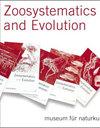Phylogenetic relationships of a new catfish of the genus Trichomycterus (Siluriformes, Trichomycteridae) from the Brazilian Cerrado, and the role of Cenozoic events in the diversification of mountain catfishes
IF 0.9
2区 生物学
Q2 ZOOLOGY
引用次数: 1
Abstract
The Brazilian Cerrado highlands shelter the headwaters of the three largest South American hydrographic basins, where a great species diversity is concentrated, but some biological groups are still insufficiently known. The focal taxa of this study are trichomycterid catfishes of the subgenus Cryptocambeva, genus Trichomycterus, endemic to mountain areas of south-eastern Brazil. The primary objective of this study is to test through a molecular phylogeny if a new species collected in streams of the upper Rio Paraná basin draining the Serra da Canastra is sister to T. macrotrichopterus, endemic to the upper Rio São Francisco at another facet of the Serra da Canastra, as suggested by morphological data. The analysis corroborated sister group relationships between these two species, besides supporting four main clades in Cryptocambeva, each of them endemic to distinct mountain regions. A time-calibrated analysis supported the divergence timing between the new species and T. macrotrichopterus at the Pliocene, which is chronologically compatible with the final period of intense fluvial configuration re-arrangement, when São Francisco headwater streams were captured by the Paraná basin. The new species herein described is similar to T. macrotrichopterus and distinguished from all other species of Cryptocambeva by having a long pectoral-fin filament. These two species are distinguished from each other by characteristics of the latero-sensory system, colour pattern and bone morphology.巴西塞拉多山鲶属一新种的系统发育关系及新生代事件在山鲶多样性中的作用(学名:siluriformia, trichomycterae
巴西塞拉多高地庇护着南美洲三个最大的水文盆地的源头,那里集中了大量的物种多样性,但一些生物类群仍然不够了解。本研究的重点分类群是巴西东南部山区特有的隐cambeva(隐cambeva)亚属毛癣属的毛癣鲶鱼。本研究的主要目的是通过分子系统发育来测试在加拿大山脉上游里约热内卢paran盆地的溪流中收集到的一个新物种是否如形态学数据所显示的那样,是大trichopterus的姐妹,大trichopterus是加拿大山脉另一侧上里约热内卢Francisco地区特有的物种。该分析证实了这两个物种之间的姐妹类群关系,除了支持隐cambea的四个主要分支外,每个分支都是不同山区特有的。一项时间校准分析支持了新种与大trichopterus在上新世的分化时间,这在时间上与最后一个剧烈的河流形态重新排列时期相一致,当时 o Francisco源流被帕拉那盆地捕获。本文所描述的新种与大trichopterus相似,并以具有长胸鳍细丝而区别于所有其他隐潜山目物种。这两个物种的区别在于它们的侧感觉系统、颜色模式和骨骼形态。
本文章由计算机程序翻译,如有差异,请以英文原文为准。
求助全文
约1分钟内获得全文
求助全文
来源期刊

Zoosystematics and Evolution
ZOOLOGY-
CiteScore
3.50
自引率
5.00%
发文量
34
审稿时长
16 weeks
期刊介绍:
Zoosystematics and Evolution, formerly Mitteilungen aus dem Museum für Naturkunde in Berlin, is an international, open access, peer-reviewed life science journal devoted to whole-organism biology. It publishes original research and review articles in the field of Metazoan taxonomy, biosystematics, evolution, morphology, development and biogeography at all taxonomic levels. The journal''s scope encompasses primary information from collection-related research, taxonomic descriptions and discoveries, revisions, annotated type catalogues, aspects of the history of science, and contributions on new methods and principles of systematics. Articles whose main topic is ecology, functional anatomy, physiology, or ethology are only acceptable when of systematic or evolutionary relevance and perspective.
 求助内容:
求助内容: 应助结果提醒方式:
应助结果提醒方式:


